For decades, the best ballers in college hoops have rocked retros on the game’s greatest stage. This year, with NIL, they can afford to like never before.
All eyes are on New Orleans for the men’s Final Four as the biggest blue bloods in basketball compete to cut down the net.
While the hype surrounding Coach K‘s final season was storybook enough to carry March Madness, a higher power has anointed another chapter: for the first time ever, Duke and North Carolina will face each other in the Final Four.
This means big bucks for CBS and hot air time for advertisers. Thankfully, the kids on the court won’t be completely boxed out when it comes to their own earnings — as players are now eligible to make money off their name, image, and likeness (NIL).
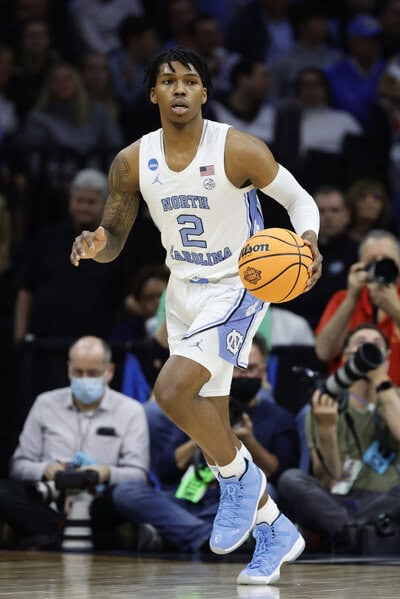
Powder blue ballers like Caleb Love have been getting to the green since the school year started. Off the court, the crafty combo guard has scored paid posts with the likes of Outback Steakhouse and the Bojangles chicken chain.
On the court, he’s branded himself as Chapel Hill’s resident sneakerhead, rotating retro Air Jordan 11s — from 2021’s “Cool Grey” launch all the way back to 2013’s “Gamma Blue” makeup. (The latter, produced when Caleb was only 13 years old.)
All season long, the St. Louis-raised sophomore has balled exclusively in patent leather retros, shelving team-wide seeded takes in favor of favorites that fetch hundreds of dollars each on StockX. For fans of footwear, it’s made Caleb’s tournament explosion all the more memorable.
Across the court, Duke phenom Paolo Banchero can play in his pick of Nike Kyrie models set to shades of black and royal, including Blue Devil branding not sold in stores. When the game pauses for TV timeouts, Paolo will still remain on screen — starring in an advertisement for retail chain JD Sports that debuted during the 2022 NBA All-Star Game.
Notably, the commercial starts with international artist SAINt JHN getting fitted for sweats before closing with the Duke freshman sifting through passports on a train. It’s just one of many paid partnerships for the future lottery pick, as he is also backed by the likes of Panini and 2K Sports.
Though Paolo might play in team-exclusive Nikes, his NIL excellence has afforded him to lace favorites from Off-White, Yeezy, and Air Jordan off the court. For many college kids, paid posts can keep them fresh in their free time.
Being stylish on and off the court as an NCAA All-American isn’t new in 2022, but it’s definitely heightened.
Fans of amateur athletics have long loved a campus hero unafraid to express themselves through footwear, and today’s loaded landscape benefits from an evolved business model. Between school sponsorships and additional discretionary income, the “feet heat” associated with college basketball is as awesome as ever in the NIL era.
How did we get here?
And where is it going?
The 2000s: A Different Durham
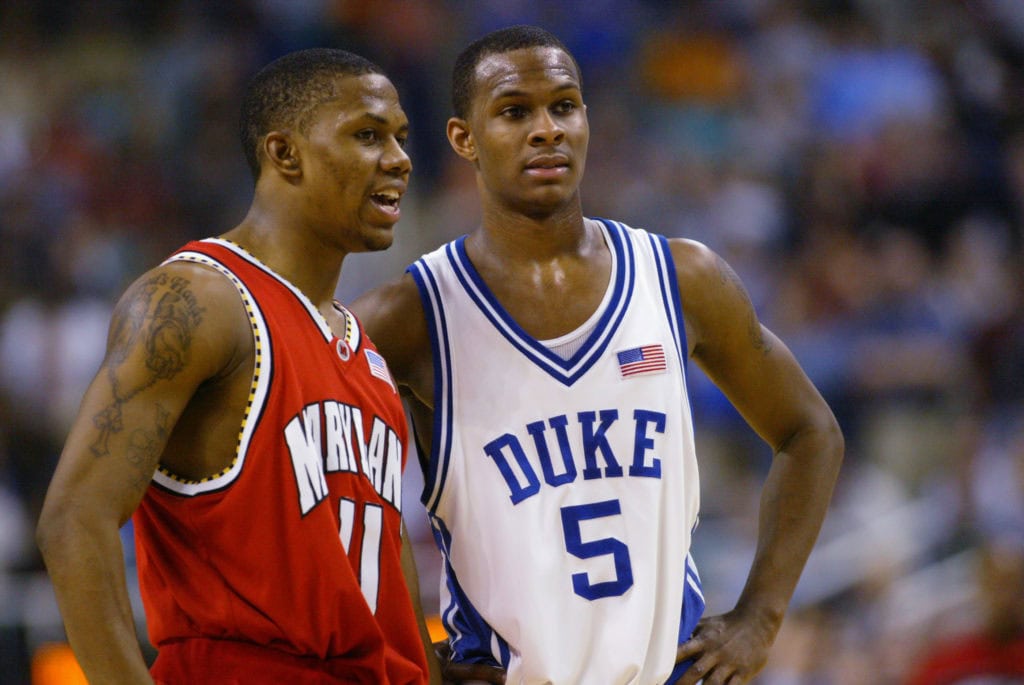
When Daniel Ewing arrived at Duke 20 seasons ago, he had one thing on his mind: winning.
Well, maybe two.
“I always had a love for sneakers,” the Blue Devil legend told Boardroom. “I always wanted to look good on the court and feel good about myself.”
Rocking No. 5 in Durham decades before Paolo played, Ewing famously rocked a rotation of celebrated sneakers that still impresses today. As a four-year favorite, the Houston-raised point guard played in Nike Air Raid retros, pairs Penny Hardaway popularized, and an array of Air Jordans despite playing for Mike’s arch-rival.
Deeply inspired by Deion Sanders’ “look good, play good” mantra, Ewing color coordinated the same styles of Bo Jackson trainers and retro Jordans that his older brothers had growing up. The seed was planted to be a sneakerhead in Ewing’s youth, allowing him to fully flourish as an All-ACC standout.
Ewing had it made.
What he didn’t have was NIL.

“Back then, you could go to the mall and get a pair of shoes,” recalled Ewing. “There were a select few Jordans where you had to make a call to have someone hold a pair, but there wasn’t the SNKRS app. You could go to the mall on a random day, and you might find yourself some gems. If you had the bread to get them, you’d grab a pair or two.”
Because Duke was a Nike school, and a conservative one at that, Ewing had access to an array of team shoes — but none that spoke to his own style. Because of this, he’d break his own bank to break out heat on the hardwood.
This scenario wasn’t singular to Ewing, but it could be avoided by selecting the right school for sneakers. Across the country, the Cincinnati Bearcats benefitted from being a Jordan Brand school, notoriously receiving retro releases by the truckload.
“When Kenny Satterfield and DerMarr Johnson came in, they were definitely getting taken care of,” former Bearcat guard Alex Meacham told Boardroom in December. “They got Air Jordan 15s way before anybody else. Pete Mickeal even had the White/Red ones.”
Conversely, Ewing searched high and low to find shoes to wear in The Tobacco Road rivalry.
“If they were a Duke colorway? I was wearing them in a game,” said Ewing, who can’t help but look at the NIL-era sneakerheads in college and laugh: “Had I been able to go in the vault and pull out anything? C’mon.”
In the early 2000s, Ewing and other student-athlete stars were breaking necks while balling on a budget. Even All-American Jameer Nelson had to phone a friend for his “Cool Grey” Air Jordan 11s as a standout at Saint Joseph’s.
“There’s an abundance of opportunities for athletes now with NIL,” Ewing said. “I think the sky would be the limit for a guy like myself, having the accolades I had coming out of high school and signing with Duke. I couldn’t put a value on it, but it would be crazy.”
Though sneaker brands targeted teen talent since the ’70s and wooed college coaches with big bags since that same era, appealing to the “sneakerhead” didn’t really start as a recruiting technique until the latter parts of the early aughts. In 2006, Compton prospect Patrick Christopher chose Cal as his college much in part to their Jordan Brand sponsorship.

Still, he’d hunt down rarities released years prior on eBay to break out in big games.
Nike noticed this behavior, leveraging their pro power and college connections to better outfit whichever college kid they thought to be next.
Only reserved for the highest-profile players or most touted teams, guys like Greg Oden and his running mates got their own LeBron exclusives at Ohio State. Similarly, Arizona point guard Jerryd Bayless benefitted from Kobe colorways not sold in stores.
By the 2010s, it was clear that to be a top collegiate program — regardless of brand — you had to up the ante on the shoes you were providing your sponsored schools.
While the next generation of preps enjoyed these perks, they promised to take it a step further.
The 2010s: PEs, Not Matching, and More
Throughout the 2010s, retros reigned on the NCAA hardwood, skewing slightly to Jordans that returned in the decade prior rather than other statement shoes rooted in the ’90s. Conversely, new Nike favorites made for Kobe Bryant, LeBron James, Kevin Durant, and Kyrie Irving began to blossom.

In turn, the signature shoes for the pro players became the team takes for the college kids. No longer was it only Oregon getting green Nike LeBron PEs, but schools like Kentucky saw their own blue Kobe colorways. This proved true at Adidas, with Kansas clad in Rock Chalk renditions of the Dame Lillard line.
While the game was evolving by amplifying marquee models through school exclusives, the real power is always in the zag. Famously, the 2012-13 Texas team took the court in “Nerf” Nike KD IVs. Limited to only 300 pairs, Kevin Durant‘s alma mater was the talk of college hoops thanks to having shoes sent otherwise only to Wale and Drake.
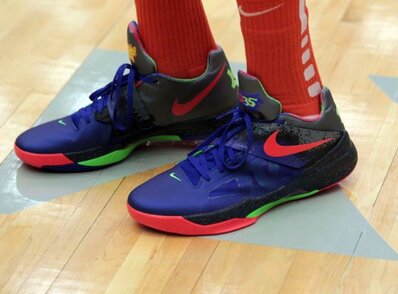
Around that same time, not matching became the new matching.
Kemba Walker went rogue at UConn, wearing aqua-accented Jordans with his navy and red uniform. This trend took over from Storrs, Connecticut, to Spokane, Washington — with kids still in grade school looking up to the new crop of college talent the same way Ewing wanted to be like Mike or even The Fab 5.
“I watched Kemba Walker and Shabazz Napier on TV throughout their tournament run switching shoes each game,” former UConn guard Jalen Adams told Boardroom. “UConn was able to build that relationship with Nike where we got PEs that nobody had. That was a big thing for me, being able to show my fashion side on the court while performing.”
Once enrolled at UConn in 2015, Adams kept the legacy alive by breaking out rare retros and team exclusives in the same spirit seen by Kemba and Shabazz years prior.

In 2018, he took collegiate heat to new heights by breaking out something special for a big game at The Mecca.
“Once people started noticing that I was a big fan of foot fire, I was able to come together with people who had connections,” said Adams. “I saved up so that once they came out with the Off-White basketball shoes, I had them. I saved them for when we played at Madison Square Garden. That was huge.”
Like Ewing a decade-and-a-half before, Adams saved money and made friends so that he could play in the rarest of releases. Unlike those days at Duke when a pair of retro Jordans retailed for $150, the Off-White x Nike Hyperdunk dropped in Virgil Abloh‘s “The Ten” for a box price of $200.
Today, that shoe sells for almost $3,000 depending on the resale site.
“StockX, GOAT? That’s where I was spending a lot of my money,” added Adams, who left UConn in 2019 — three seasons before NIL began. “If I was able to promote them while also benefiting myself? That would’ve been huge for me.”
When looking at the first season of NIL in NCAA hoops, plenty of brazen ballers have been leveraging their likeness for the “foot fire” Adams and others long sought.
The 2020s: NIL & the New Old
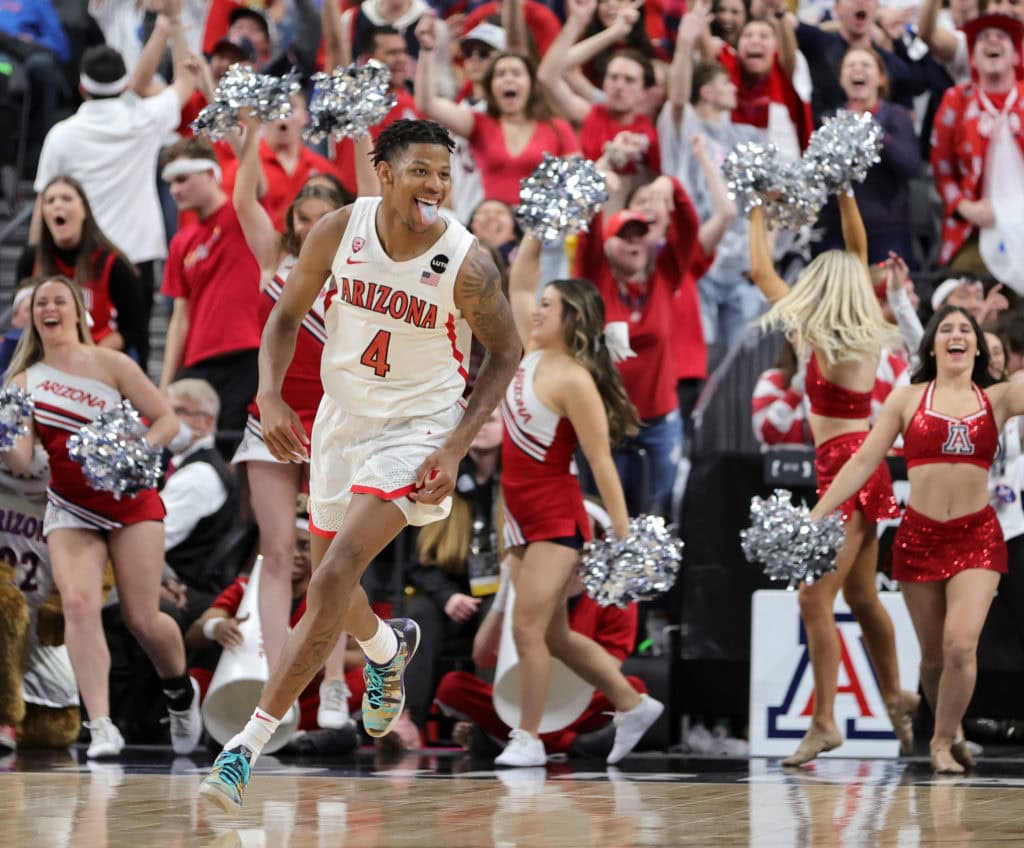
From Bojangles to Buffalo Wild Wings, college kids are eating off NIL.
This is true in hoop havens like Chapel Hill or Durham as well as in Tucson.
Standing 6-foot-7 and possessing the ability to make and finish plays, Arizona Wildcats guard Dalen Terry epitomizes heat and highlights in 2022. More modern than his predecessors, Terry takes on-court flair to another level from his look-away passes to his three-point celebrations. While all-conference accolades and air-guitar antics make Terry a fan favorite in Tucson, it’s his shoe game that makes him a man among boys.
“All my teammates are like, ‘You’re gonna be like PJ Tucker!’ Terry said, smiling. “And I go, ‘Nah, I’m gonna be better. I just started earlier than him.'”
Terry balls in heat at the house Lute Olson built, and he flexes in fits on the platforms Mark Zuckerberg owns. Terry is a trendsetter on the hardwood and in the boardroom.
“Dalen was able to leverage his social media following with a post endorsing Reebok kicks sponsored by Champs Sports, even though his team is sponsored by Nike,” Julian Aiken, athlete advisor at PWRFWD, told Boardroom. “While rare, these types of deals are possible if your brand’s strong enough to endorse kicks off the court.”
As Terry tells it, Champs Sports reached out to collab. In short order, Terry agreed and shot the promotional video on campus. At the time of publishing, Terry’s paid post has already amassed almost 12,000 views. The pair profiled in the video was a “Pink Toe” take on the Reebok Question: an Allen Iverson signature shoe from 1997 that newly named Seton Hall coach Shaheen Holloway wore when he played for the Pirates.
While the Reebok Question has Cinderella slipper stories in the rich history of March Madness, the paid post provided Terry with his first pair. In fact, he liked them so much that he bought a few more colorways to wear off-court. Champs Sports aside, Terry pulls income from Vibe Boost NFT, local ice cream shop The Screamery, and even his own clothing brand, Publicly Private.
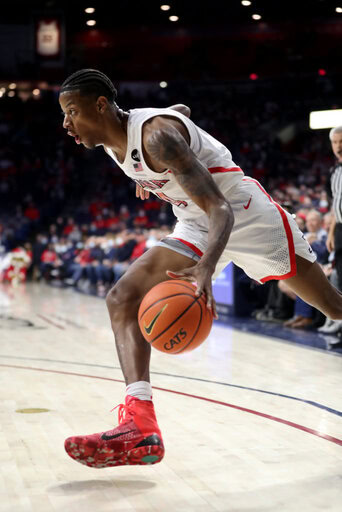
“It helped a lot,” Terry told Boardroom when asked about NIL and its impact on his shoe game. “I’m using my money wisely. I save some, for sure. But as a sneakerhead? You’ve always gotta get a pair of shoes. Whenever I get a little extra money, I look for some old kicks to see what I can bring out next.”
Terry’s love of his sneakers started in his youth. He cites middle school as the turning point.
“I used to save all my money from chores and spend it on shoes,” Terry said. “Christmas time? I’m getting shoes every year. That’s since sixth grade.”
Though Terry boasts access to an Arizona equipment room lauded as legendary, he takes his rotation a step further by buying the basketball shoes he wanted when he was dreaming of this day.
“I like the older stuff,” admitted Terry. “All the Kobes, the old Hyperdunks, KD 4s, KD 5s, KD 6s. I’ve been looking for the Krispy Kreme Kyrie 2s for the longest. I like a lot of the old LeBron Soldiers from when he was with Cleveland in the beginning.”
For a 19-year-old like Terry, the old stuff is what was once new to a 2000s star like Daniel Ewing or even a 2010s talent like Tyler Jerome. As an Arizona enrollee and member of Gen Z, the golden era for Nike Basketball begins with landing LeBron and ends with Kobe scoring 60. Though Terry still favors fly flavors from Off-White and Balenciaga when arriving at games, his affinity for new nostalgia proves apparent on court.
Such was the case as Terry’s sophomore season ended in the Sweet 16 at the hands of the Jordan Brand-sponsored Houston Cougars. Leading the Wildcats in points, rebounds, and assists, Terry also outshined all by breaking out the “All-Star” Nike Kobe 1 Protro — a style worn by Bryant back in 2006, only to be revised and re-released in 2018.
Terry was three years old when Kobe first wore the asymmetrical style from Nike and was just old enough to drive to his Compton Magic AAU games when they resurfaced. Though Terry can always go to the equipment room and grab a pair of team-toned Kyries or other Nike Basketball new releases, he frequents consignment shops and searches eBay for all the pairs that alluded him as a kid.
Former Virginia star Ty Jerome, now a guard for the Oklahoma City Thunder, takes the same approach as a pro.
“What appealed to you as a kid that you couldn’t have? Now that you have access to it, you’re going to gravitate to it,” Jerome told Boardroom. At Virginia, Jerome was able to cut down the nets in a pair of Nike Kobe Protros just as Terry dreamed of doing.
If Terry returns to Tucson to chase a title, his top competition on foot will be teammate Shane Nowell. The fellow Wildcat benefits from a big brother playing in the NBA — Minnesota Timberwolves guard Jaylen Nowell — and shares the same shoe size as Terry. Because of this, the two often swap shoes throughout the season.
Back on campus, Terry’s already taken home a NIL deal with FashionNova. With that income, he hopes to play in DeMar DeRozan’s patent leather Protro PEs the next time he takes the court — whether at Arizona for another season or in the NBA.
“I’m weighing my options, but whatever I do next? There’s gonna be some crazy kicks involved,” Terry promised.
Who’s Got Next?
There’s no telling just where NIL will go from here.
Months ago, prep phenom Shaedon Sharpe made headlines by signing a deal with sneaker community SoleSavy. Though early enrollment and NBA lottery projections may keep Sharpe from ever playing a game at Rupp Arena, his shoe rotation and earnings are already in good shape.
Similarly, if Caleb Love comes back to Carolina for his junior season, he’s built equity as a fan favorite and sneaker superstar. In a Sweet 16 showdown with UCLA, Love started the game in “Space Jam” 11s before pulling a PJ Tucker at halftime, switching into the same silo in its very rare “Ultimate Gift of Flight” colorway.

The move worked as Love caught fire in the second half, scoring 27 more points and punching a ticket to the next round. Just the same, it could earn him a deal with a sneaker supplier.
Moving forward, athlete advisors like Julian Aiken are estimating that value for current athletes while monitoring moves in the market. Next season and beyond, Aiken sees big brands in the sneaker space centering on hyper-focused demographic marketing as a way to allow global brands to dive deeper into college communities with messaging that matters.
Previews of this have been seen in campaigns such as Champion’s L.A.-based ad starring UCLA softball star Maya Brady as well as Adidas’ announcement to directly pay players attending three-stripe-sponsored schools
“Players now have money to invest in things such as social media strategy and content without having to spend time worrying if their family will be able to attend their home games,” Aiken explained. “Athletes will now be able to build out the visions and brand they know themselves to be.”